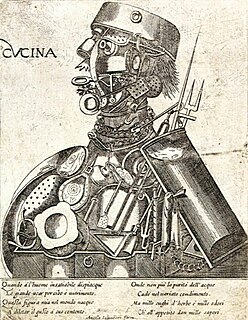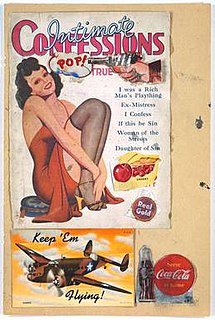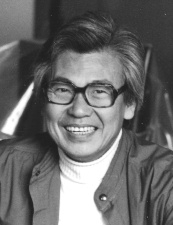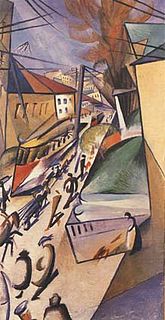 W
WThe avant-garde is a person or work that is experimental, radical, or unorthodox with respect to art, culture, or society. It is frequently characterized by aesthetic innovation and initial unacceptability.
 W
WThe California Clay Movement was a school of ceramic art that emerged in California in the 1950s. The movement was part of the larger transition in crafts from "designer-craftsman" to "artist-craftsman". The editor of Craft Horizons, New York-based Rose Slivka, became an enthusiastic advocate of the movement.
 W
WCyborg art, also known as cyborgism, is an art movement that began in the mid-2000s in Britain. It is based on the creation and addition of new senses to the body via cybernetic implants and the creation of art works through new senses. Cyborg artworks are created by cyborg artists; artists whose senses have been voluntarily enhanced through cybernetic implants. Among the early artists shaping the cyborg art movement are Neil Harbisson, whose antenna implant allows him to perceive ultraviolet and infrared colours, and Moon Ribas whose implants in her feet allow her to feel earthquakes and moonquakes. Other cyborg artists include:Manel De Aguas, a Catalan photographer who developed fins that allow him to perceive atmospheric pressure, humidity and temperature through a couple of implants at each side of his head. Joe Dekni, an artist who has developed and installed a radar system in his head. The sensory system includes two implants in his cheekbones. Pau Prats, creator of a system that allows him to feel the ultraviolet ray levels that reach his skin. Alex Garcia, whose sensor installed in his chest allows him to feel the air quality levels around him. Kai Landre, a musician developing two implants to hear the sound of the particles affected by the collusion of cosmic rays.
 W
WDada or Dadaism was an art movement of the European avant-garde in the early 20th century, with early centres in Zürich, Switzerland, at the Cabaret Voltaire. New York Dada began c. 1915, and after 1920 Dada flourished in Paris. Dadaist activities lasted until c. the mid 1920s.
 W
WIn 1961, filmmaker Gene Bernofsky and artist Clark Richert, art students from the University of Kansas, developed an art concept they called Drop Art or droppings. Informed by the "happenings" of Allan Kaprow and the impromptu performances a few years earlier of John Cage, Robert Rauschenberg and Buckminster Fuller at Black Mountain College, Drop Art began when Richert and Bernofsky started painting rocks and dropping them from a loft roof onto the sidewalk of Lawrence Kansas's main drag — watching the reactions of passersby. Early Drop Art included such pieces as Egg Drop and Pendulum (pictured).
 W
WExperimental film, experimental cinema, or avant-garde cinema is a mode of filmmaking that rigorously re-evaluates cinematic conventions and explores non-narrative forms or alternatives to traditional narratives or methods of working. Many experimental films, particularly early ones, relate to arts in other disciplines: painting, dance, literature and poetry, or arise from research and development of new technical resources.
 W
WThe Firehouse Theater of Minneapolis and later of San Francisco was a significant producer of experimental, theater of the absurd, and avant guard theater in the 1960s and 1970s. Its productions included new plays and world premieres, often presented with radical or inventive directorial styles. The Firehouse introduced playwrights and new plays to Minneapolis and San Francisco. It premiered plays by Megan Terry, Sam Shepard, Jean-Claude van Itallie, María Irene Fornés and others; and it presented plays by Harold Pinter, John Arden, August Strindberg, John Osborne, Arthur Kopit, Eugène Ionesco, Berthold Brecht, Samuel Beckett and others. In a 1987 interview Martha Boesing, the artistic director of another Minneapolis theatre, described the Firehouse Theater as "the most extreme of all the groups creating experimental theater in the sixties, and the closest to Artaud’s vision." Writing in 1968, The New York Times said that the Firehouse Theater "has been doing avantgarde plays in Minneapolis nearly as long as the Tyrone Guthrie Theater has been doing the other kind, and with much less help from the Establishment." That same year, when a federal grant was provided to support the Firehouse, it was pointed out in the Congressional Record that the Firehouse Theatre "is the only major theatre dealing experimentally with the writing of plays and their production outside the metropolitan New York area."
 W
WFluxus was an international, interdisciplinary community of artists, composers, designers and poets during the 1960s and 1970s who engaged in experimental art performances which emphasized the artistic process over the finished product. Fluxus is known for experimental contributions to different artistic media and disciplines and for generating new art forms. These art forms include intermedia, a term coined by Fluxus artist Dick Higgins; conceptual art, first developed by Henry Flynt, an artist contentiously associated with Fluxus; and video art, first pioneered by Nam June Paik and Wolf Vostell. Dutch gallerist and art critic Harry Ruhé describes Fluxus as "the most radical and experimental art movement of the sixties."
 W
WFuturism was an artistic and social movement that originated in Italy in the early 20th century which later also developed in Russia. It emphasized dynamism, speed, technology, youth, violence, and objects such as the car, the airplane, and the industrial city. Its key figures were the Italians Filippo Tommaso Marinetti, Umberto Boccioni, Carlo Carrà, Fortunato Depero, Gino Severini, Giacomo Balla, and Luigi Russolo. It glorified modernity and aimed to liberate Italy from the weight of its past. Important Futurist works included Marinetti's Manifesto of Futurism, Boccioni's sculpture Unique Forms of Continuity in Space, Balla's painting Abstract Speed + Sound, and Russolo's The Art of Noises.
 W
WGaur was a Basque artistic group founded in 1966 by Amable Arias, Rafael Ruiz Balerdi, Nestor Basterretxea, Eduardo Chillida, Remigio Mendiburu, Jorge Oteiza, José Antonio Sistiaga, and José Luis Zumeta. The avant-garde group, based in Gipuzkoa, Spain, provided the springboard for a wide Basque artistic movement with close links to influential social, cultural and political agents in the Basque Country opposed to Franco's dictatorship during the 70s and early 80s.
 W
WAvant-garde is French for "vanguard". The term is commonly used in French, English, and German to refer to people or works that are experimental or innovative, particularly with respect to art and culture.
 W
WSante Monachesi (1910-1991), was an Italian painter belonging to the modern movement of the Scuola romana and founder in 1932 of the Movimento Futurista nelle Marche .
 W
WNeo-futurism is a late-20th to early-21st-century movement in the arts, design, and architecture.
 W
WNeue Slowenische Kunst is a political art collective that formed in Slovenia in 1984, when Slovenia was part of Yugoslavia. NSK's name was chosen to reflect the theme in its works of the complicated relationship Slovenes have had with Germans. The name of NSK's music wing, Laibach, is also the German name of the Slovene capital Ljubljana. The name created controversy because some felt it evoked memories of the Nazi annexation of Slovenia during the Second World War. It also refers to Slovenia's previous seven centuries as part of the Habsburg Monarchy.
 W
WPafama, short for Papierfarbenmalerei, is a 1922 painting by Croatian painter Josip Seissel. This painting is the first known abstract composition in Croatian art. It is currently in the collection of the Museum of Contemporary Art, Zagreb.
 W
WPilgrimage to Cedars of Lebanon is a picture of the Hungarian painter Tivadar Csontváry Kosztka of 1907.
 W
WPinacotheca (1967–2002) was a gallery in Melbourne, Australia. Established in 1967 by Bruce Pollard, it was ideologically committed to the avant-garde and represented a new generation of artists interested in post-object, conceptual and other non-traditional art forms.
 W
WPop art is an art movement that emerged in the United Kingdom and the United States during the mid- to late-1950s. The movement presented a challenge to traditions of fine art by including imagery from popular and mass culture, such as advertising, comic books and mundane mass-produced objects. One of its aims is to use images of popular culture in art, emphasizing the banal or kitschy elements of any culture, most often through the use of irony. It is also associated with the artists' use of mechanical means of reproduction or rendering techniques. In pop art, material is sometimes visually removed from its known context, isolated, or combined with unrelated material.
 W
WThe Salon des Refusés, French for "exhibition of rejects", is generally known as an exhibition of works rejected by the jury of the official Paris Salon, but the term is most famously used to refer to the Salon des Refusés of 1863.
 W
WSignalism represents an international neo-avant-garde literal and art movement. It gathered wider support base both in former Yugoslavia and the world in the late 1960s and the beginning of the 1970s.
 W
WBoris Smirnoff was a Franco-Russian cubist, avant-gardist and analytical art painter.
 W
WSt Sebastian is a 20th-century painting by the Bohemian artist Bohumil Kubišta. Saint Sebastian was a Christian martyr. It is held in the National Gallery in Prague.
 W
WDe Stijl, Dutch for "The Style", also known as Neoplasticism, was a Dutch art movement founded in 1917 in Leiden. De Stijl consisted of artists and architects. In a more narrow sense, the term De Stijl is used to refer to a body of work from 1917 to 1931 founded in the Netherlands. Proponents of De Stijl advocated pure abstraction and universality by a reduction to the essentials of form and colour; they simplified visual compositions to vertical and horizontal, using only black, white and primary colors.
 W
WA.G. Syjuco, also known as Black Leather Birds, is a music producer, composer, and musician originally from Manila, Philippines. He is the eldest son of avant-garde artists Cesare Syjuco and Jean Marie Syjuco and is the producer, principal composer, and primary instrumentalist of the experimental rock band Jack of None.
 W
WCesar Augusto "Cesare" Limcaco Syjuco is a multi-media artist, painter, poet and art critic from Manila, Philippines.
 W
WJean Marie Syjuco is a painter, installation artist, and performance artist from Manila, Philippines.
 W
WMaxine Syjuco is an artist, poet and model from Manila, Philippines. She is the youngest daughter of avant-garde artists Cesare Syjuco and Jean Marie Syjuco, and is the vocalist and songwriter of the experimental Art Rock band Jack of None.
 W
WTeatr Tworzenia, or The Theater of Creation, Polish avant-garde theater, founded by Jarosław Pijarowski. According to the author's definition it is: "Uninstitutionalized form of realization of creative ideas, consisting on intuitive-improvisational thematic activities; Have on the goal of integration and promotion of creative thought in audio-visual forms. The Theater of Creation does not have a permanent place, which is related to the idea -Live Act - live creation according to a previously accepted scenario, for the audience with no time, space or space constraints, more than once with the audience.
 W
WClara Tice was an American avant-garde illustrator and artist, who spent most of her life in New York City, United States. Because of her provocative art and public appearances, she was seen as representative of bohemian Greenwich Village and thus known as "The Queen of Greenwich Village."
 W
WMiroljub Todorović is a Serbian poet and artist. He is the founder and theoretician of Signalism, an international avant-garde literary and artistic movement. He is also editor-in-chief of the International review "Signal".
 W
WWen-Ying Tsai was a Chinese-American pioneer cybernetic sculptor and kinetic artist best known for creating sculptures using electric motors, stainless steel rods, stroboscopic light, and audio feedback control. As one of the first Chinese-born artists to achieve international recognition in the 1960s, Tsai was an inspiration to generations of Chinese artists around the world.
 W
WUkrainian avant-garde is a term widely used to refer the most innovative metamorphosises in Ukrainian art from the end of 1890s to the middle of the 1930s along with associated artists. Broadly speaking, it is Ukrainian art synchronized with the international avant-garde in sculpture, painting, literature, cinema, theater, stage design, graphics, music, architecture. Some Ukrainian avant-garde artists who are fairly well-known include Kazimir Malevich, Alexander Archipenko, Vladimir Tatlin, Sonia Delaunay, Vasyl Yermylov, Alexander Bogomazov, Aleksandra Ekster, David Burliuk, Vadym Meller, Anatol Petrytsky all of them were closely connected to Ukrainian cities Kyiv, Kharkiv, Lviv, Odessa by birth, education, language, national traditions or identity. One of the earliest uses of the term "Ukrainian Avant-Garde" concerning painting and sculpture during Soviet censorship was in the artistic discussion at Tatlin's dream exhibition, curated by Parisian art historian Andréi Nakov, in London, 1973, which showcased works of Ukrainian artists Vasyl Yermylov and Alexander Bogomazov. The first international avant-garde exhibitions in Ukraine which included French, Italian, Ukrainian and Russian artists took place in Odessa and Kyiv at the Izdebsky Salon; later the pieces were shown in St. Petersburg and Riga. The cover of "Izdebsky Salon 2" (1910–11) contained abstract work by Wassily Kandinsky.
 W
WUno Vallman was a Swedish painter.
 W
WWonderloch Kellerland was an international project and exhibition space founded by René Luckhardt in his Berlin apartment in the beginning of 2010. The name relates to Dostoyevsky’s Notes from Underground and Lewis Carroll’s Alice's Adventures in Wonderland. A role model was also Ludwig II of Bavaria, the “greatest Kellerloch-artist of all times”. The German magazine Art Das Kunstmagazin refers to Wonderloch Kellerland as the “boot camp of subculture”.